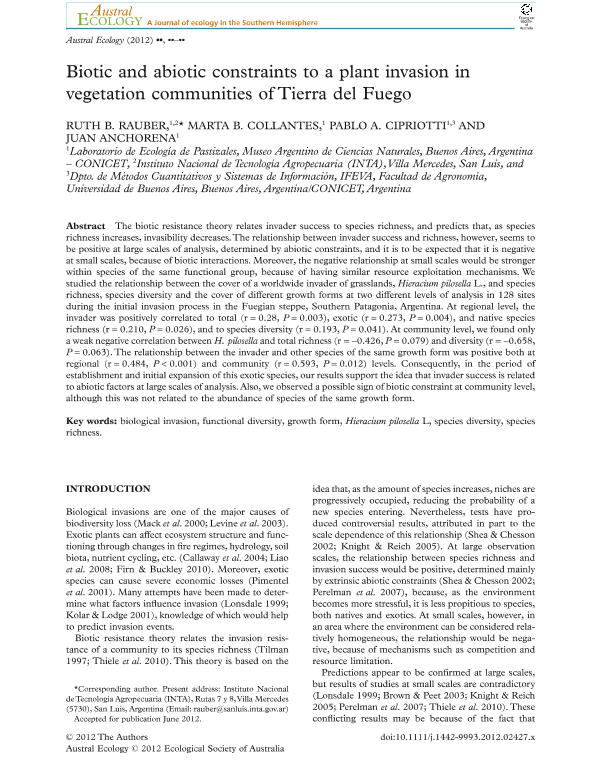Mostrar el registro sencillo del ítem
dc.contributor.author
Rauber, Ruth Bibiana

dc.contributor.author
Collantes, Marta Beatriz

dc.contributor.author
Cipriotti, Pablo Ariel

dc.contributor.author
Anchorena, Juan
dc.date.available
2016-02-17T21:01:58Z
dc.date.issued
2013-05
dc.identifier.citation
Rauber, Ruth Bibiana; Collantes, Marta Beatriz; Cipriotti, Pablo Ariel; Anchorena, Juan; Biotic and abiotic constraints to a plant invasion in vegetation communities of Tierra del Fuego; Wiley; Austral Ecology; 38; 4; 5-2013; 436-442
dc.identifier.issn
1442-9985
dc.identifier.uri
http://hdl.handle.net/11336/4254
dc.description.abstract
The biotic resistance theory relates invader success to species richness, and predicts that, as species richness increases, invasibility decreases.The relationship between invader success and richness, however, seems to be positive at large scales of analysis, determined by abiotic constraints, and it is to be expected that it is negative at small scales, because of biotic interactions. Moreover, the negative relationship at small scales would be stronger within species of the same functional group, because of having similar resource exploitation mechanisms. We studied the relationship between the cover of a worldwide invader of grasslands, Hieracium pilosella L., and species richness, species diversity and the cover of different growth forms at two different levels of analysis in 128 sites during the initial invasion process in the Fuegian steppe, Southern Patagonia, Argentina. At regional level, the invader was positively correlated to total (r = 0.28, P = 0.003), exotic (r = 0.273, P = 0.004), and native species richness (r = 0.210, P = 0.026), and to species diversity (r = 0.193, P = 0.041). At community level, we found only a weak negative correlation between H. pilosella and total richness (r = -0.426, P = 0.079) and diversity (r = -0.658, P = 0.063). The relationship between the invader and other species of the same growth form was positive both at regional (r = 0.484, P < 0.001) and community (r = 0.593, P = 0.012) levels. Consequently, in the period of establishment and initial expansion of this exotic species, our results support the idea that invader success is related to abiotic factors at large scales of analysis. Also, we observed a possible sign of biotic constraint at community level, although this was not related to the abundance of species of the same growth form.
dc.format
application/pdf
dc.language.iso
eng
dc.publisher
Wiley

dc.rights
info:eu-repo/semantics/openAccess
dc.rights.uri
https://creativecommons.org/licenses/by-nc-sa/2.5/ar/
dc.subject
Biological Invasion
dc.subject
Functional Diversity
dc.subject
Growth Form
dc.subject
Hieracium Pilosella L.
dc.subject
Species Diversity
dc.subject
Species Richness
dc.subject.classification
Ecología

dc.subject.classification
Ciencias Biológicas

dc.subject.classification
CIENCIAS NATURALES Y EXACTAS

dc.title
Biotic and abiotic constraints to a plant invasion in vegetation communities of Tierra del Fuego
dc.type
info:eu-repo/semantics/article
dc.type
info:ar-repo/semantics/artículo
dc.type
info:eu-repo/semantics/publishedVersion
dc.date.updated
2016-03-30 10:35:44.97925-03
dc.journal.volume
38
dc.journal.number
4
dc.journal.pagination
436-442
dc.journal.pais
Estados Unidos

dc.journal.ciudad
Hoboken
dc.description.fil
Fil: Rauber, Ruth Bibiana. Consejo Nacional de Investigaciones Científicas y Técnicas. Oficina de Coordinación Administrativa Parque Centenario. Museo Argentino de Ciencias Naturales; Argentina. Instituto Nacional de Tecnología Agropecuaria. Centro Regional Corrientes. Estación Experimental Agropecuaria Mercedes; Argentina
dc.description.fil
Fil: Collantes, Marta Beatriz. Consejo Nacional de Investigaciones Científicas y Técnicas. Oficina de Coordinación Administrativa Parque Centenario. Museo Argentino de Ciencias Naturales; Argentina
dc.description.fil
Fil: Cipriotti, Pablo Ariel. Consejo Nacional de Investigaciones Científicas y Técnicas. Oficina de Coordinación Administrativa Parque Centenario. Museo Argentino de Ciencias Naturales; Argentina. Universidad de Buenos Aires. Facultad de Agronomía. Departamento de Métodos Cuantitativos y Sistemas de Información; Argentina. Consejo Nacional de Investigaciones Científicas y Técnicas. Oficina de Coordinación Administrativa Parque Centenario. Instituto de Investigaciones Fisiológicas y Ecológicas Vinculadas a la Agricultura; Argentina
dc.description.fil
Fil: Anchorena, Juan. Consejo Nacional de Investigaciones Científicas y Técnicas. Oficina de Coordinación Administrativa Parque Centenario. Museo Argentino de Ciencias Naturales; Argentina
dc.journal.title
Austral Ecology

dc.relation.alternativeid
info:eu-repo/semantics/altIdentifier/url/http://onlinelibrary.wiley.com/doi/10.1111/j.1442-9993.2012.02427.x/abstract
dc.relation.alternativeid
info:eu-repo/semantics/altIdentifier/doi/http://dx.doi.org/DOI:10.1111/j.1442-9993.2012.02427.x
dc.relation.alternativeid
info:eu-repo/semantics/altIdentifier/issn/1442-9985
Archivos asociados
